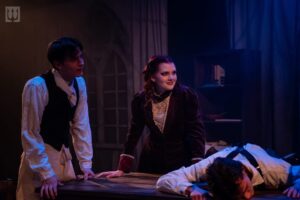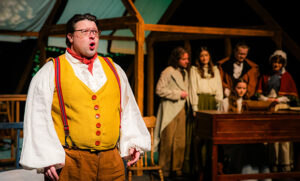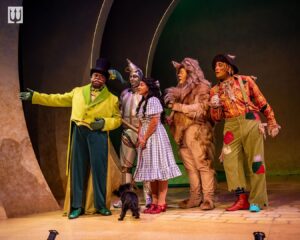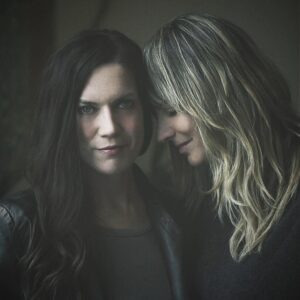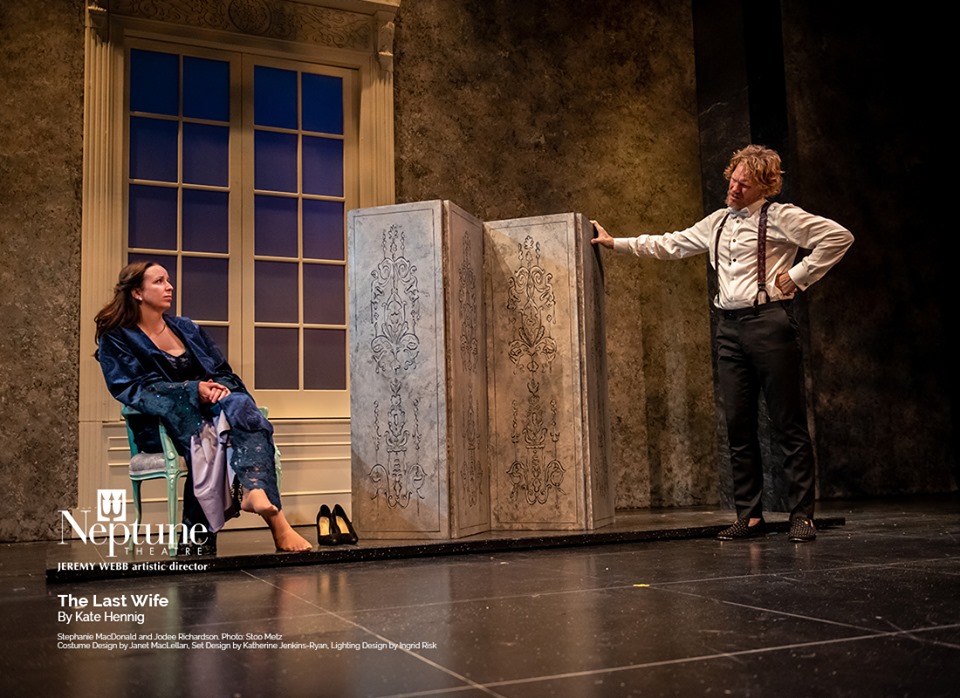
I vividly remember learning about the Tudors in History Class in Grade Nine at Sacred Heart School. I was an enthusiastic History student and I happily soaked up as much information about Henrys and Edwards as my textbook would provide. It was especially revealing to me, then, when I had to do a few quick Wikipedia searches before the media call for The Last Wife at Neptune Theatre earlier this week because I couldn’t remember who Katherine Parr and Princess Mary were. I went to an all-girls school, my history teacher was a very intelligent young woman, and yet I remembered so vividly learning about Henry VIII, but the wives he had murdered, and the one who lived, had seemed then more like the sideshow than the real story. I’m realizing now how fundamentally disturbing this historical narrative is.
Kate Hennig shines the spotlight in The Last Wife ardently on Katherine “Kate” Parr, Henry VIII’s sixth wife and the only one who outlived him. It is a contemporary re-imagining of herstory, where the costumes and the language bring this story to vivid, immediate life, and the facts are dramatically accurate. This play tells the fascinating story of how Kate used whatever influence she could accrue to help Henry’s children, particularly his daughters Mary (the future Queen Mary I) and Bess (the future Queen Elizabeth I) to become well educated, empowered, and to know a mother’s love after all theirs were brutally and unfairly taken from them. For Mary and Bess, especially, Kate fought for their rights to be seen as Princesses and to restore them to the line of Succession to the Throne, which paved the way for both to eventually become Queens of England. At its core this is a factually accurate story about a woman in the 1540s using her political power to embolden, support, and advance the position of two other women, even when it meant putting her own life in very real danger. The fact that this story isn’t universally known is an unsurprising travesty. The play also delves into the complex relationship between Kate and her husband. How can a woman who is so progressive connect with an abusive man-child who has the absolute power to kill anyone he wants and uses this power routinely and on a whim? Is it possible for Mary and Bess to ever have a father/daughter relationship with Henry knowing how horribly he treated their mothers? Hennig does a beautiful job here of finding the humanity in all her characters and showing how they all suffer the effects of Toxic Masculinity, the Patriarchy, and the political and societal infrastructures that both have created; and we see that these infrastructures endure and continue to wreak havoc to this day.
This play feels very filmic, its set design by Katherine Ryan, costume design by Janet MacLellan, and sound design by Aaron Collier, are sleek and crisp and root us in the ambiance of the inner lives of the elite; it feels like this story is jumping off the pages of Vogue. The scenes are often brisk and short, which helps to build the play’s sense of urgency, of time moving, and keeps a narrative that could be dense with complex details streamlined and clear. The play is also very funny, often darkly and wryly so, but Hennig and director Natasha MacLellan do a great job of using humour to give levity and light to balance the darkness and weightiness of a world entrenched in violence and war.
David Patrick Flemming plays Thom Seymour, the man that Kate loves, whose life is perpetually at the mercy of Henry VIII. Seymour’s real-life trajectory could be its own play (as is the case with all the characters here), and Flemming does a great job of showing the effects of Kate’s marriage to Henry coupled with his own political ambition, without a lot of stage time. We want Thom to be a hero among men here, and his truth really showcases how this toxic mixture of power, wealth and “masculine” ambition corrupts and corrodes everyone it touches. Lesley Smith plays Mary with intense fire and bitterness; we see flashes of her maybe wanting to connect with Kate and Bess, but ultimately she understands that her power is rooted in her rage and that it is prudent not to trust anyone. Smith does a lovely job of encouraging the audience to empathize with Mary, but not at the expense of her strength. Given that “Bloody” Mary will grow up to have almost 300 people burned at the stake, it is a fascinating insight into her early life. Isaac Neaves plays young Eddie (the future King Edward VI), the next in line to the throne, who represents all the sweet innocence inherent in children before they are truly influenced by the misogynistic systems in the world. Neaves has a beautiful dynamic with both Flemming (as his uncle Thom) and Stephanie MacDonald (as Kate), and he gives the play so much light, humour and heart. Hennig insinuates here that perhaps if Eddie had been able to remain with Kate (the only mother figure he ever knew), rather than being whisked away by the power-hungry male council after the death of his dad, he would have made better choices as King.
Koumbie also plays Bess with a wide-open heart, as a young girl who wants so much to connect with her stepmother, her sister and brother, and her father. She is the most obviously influenced by Kate and we see her grow from a girl whose only connotation with Royalty is ornate gowns to a young woman poised to educate herself in whatever ways necessary to make shrewd decisions and to help serve her country. The very last moment of the play is Bess’ and seeing Koumbie stand there in that spotlight is emotional, empowering and triumphant. Jodee Richardson plays Henry as sort of the Captain Jack Sparrow of Kings, but without Jack’s ultimately redeeming qualities. He is off kilter and unpredictable, darkly funny, but also with a deep vulnerability that keeps bubbling to the surface despite Henry’s attempts to eradicate it from his personality. What is so wonderfully frustrating about this play is how likeable Richardson can be, and how at times even his relationship with MacDonald’s Kate feels romantic. It’s easy to see how Kate can be confused and undecided about her feelings toward her husband, as we are also rooting for his humanity and his kindness to prevail over the toxic ideas of masculinity, power, strength, monarchy, and Great Britian as a whole that he has been inundated with since he was a child. This doesn’t in any way excuse his monstrous behaviour, but it’s fascinating to see a play where a character’s tragic flaw is the way that he has chosen (and been conditioned) to be a “man.”
The Last Wife requires a powerhouse performance for Kate and gets it in spades from Stephanie MacDonald. She brings so much strength to Kate, but shows how sometimes strength comes in comforting a scared child, nursing a sick man, teaching a younger woman, or even in asking for help and advice. Kate is continually making compromises with her ideals for what she sees as being the greater good, either for the country, for her stepchildren, or for her own wellbeing and MacDonald brings all these complex emotions to her scenes with nuance, heart, and vibrance. At the same time, Kate is also remarkable in her ability to express her boundaries and her expectations with a clarity and courage that is rarely seen onstage, especially not in historical dramas. Hennig writes Kate as a beautifully three dimensional human, a woman of intelligence, wit, empathy, ambition, and the ability to dream of a better and more equal future, not just for women, but to the benefit of all of England. MacDonald truly inhabits all of these qualities and does beautiful justice to Queen Katherine Parr.
Bringing all these elements together is Director Natasha MacLellan, whose nuanced guiding hand is clear in the ways that the characters’ movements reflect the fact that this is a story told from a female perspective. I realized watching this play how accustomed I am to seeing portrayals of sex and violence from the male perspective in ways that can feel superfluous and voyeuristic, and how when that lens is removed it becomes an opportunity for me to engage on a deeper level with the characters in the scene I’m watching.
It’s been almost twelve years since I started writing theatre reviews for TWISI, and I have spent the last two decades being an active theatregoer and it strikes me still how rare it is to see a play written by a Canadian woman, about a woman (especially one who really existed), directed by a Nova Scotian woman on our regional theatre stage. The Last Wife is a much overdue and palatable shift in perspective for me and the effect is an electrifying, fascinating, and triumphant evening at the theatre. I won’t forget who Queen Katherine Parr or Queen Mary I were ever again, and my insights into the Tudor dynasty have been thoughtfully changed and expanded by this play.
The Last Wife by Kate Hennig, directed by Natasha MacLellan plays at Neptune Theatre’s Fountain Hall Stage (1593 Argyle Street, Halifax) from now through October 6th, 2019. Performances are Tuesdays to Sundays at 7:30pm and 2:00pm on Saturdays and Sundays. Tickets range in price from $84.00- $30.00. Industry Night is Tuesday, September 17 at 7:30pm and Talkback Night is Wednesday, September 18 at 7:30pm. For Tickets please call 902.429.7070, visit the Box Office in person at 1593 Argyle Street, or buy online at this website.
You can follow Neptune Theatre on Social Media: Facebook. Twitter. Instagram (@NeptuneTheatre) #HFXLastWife

